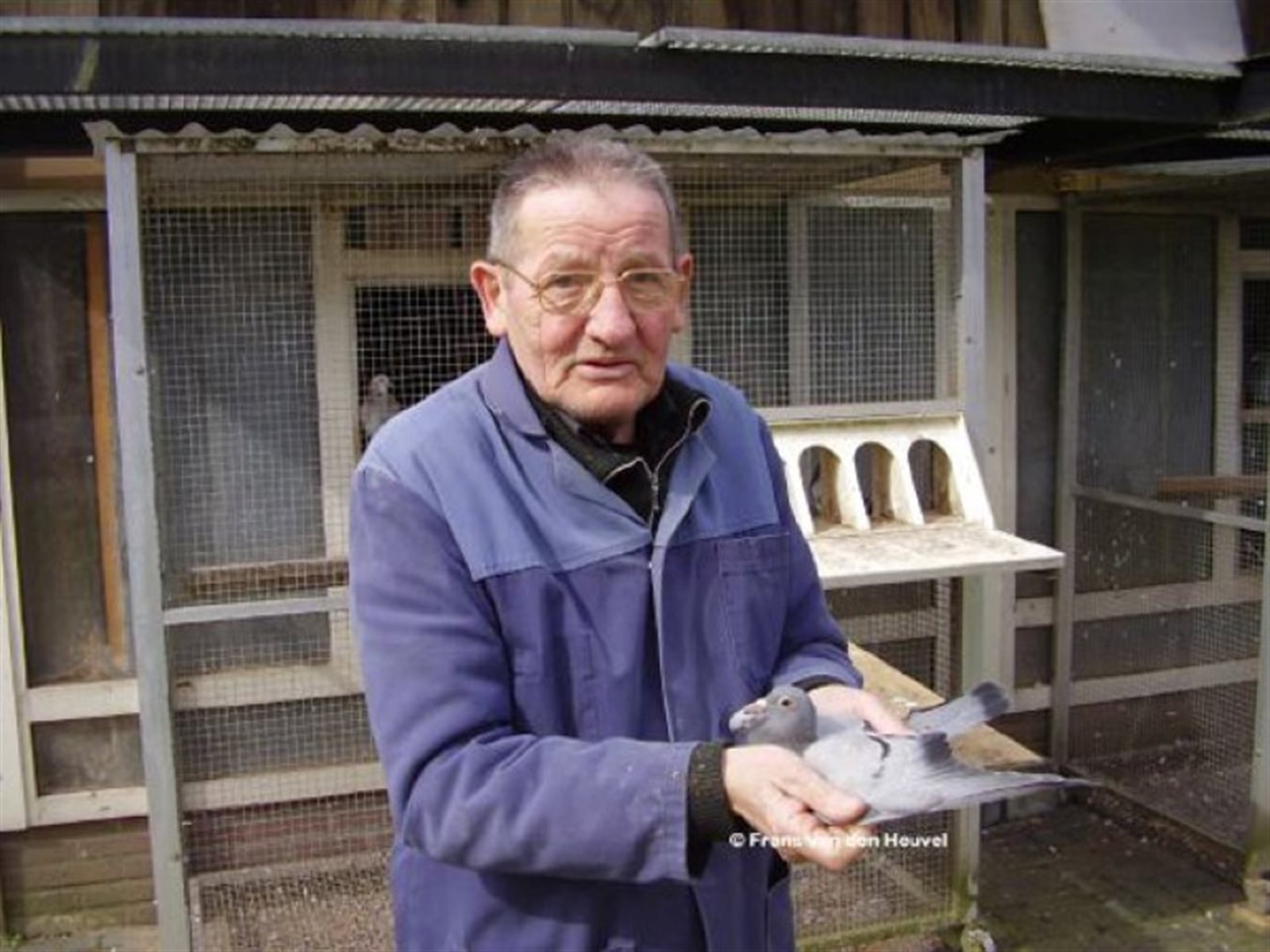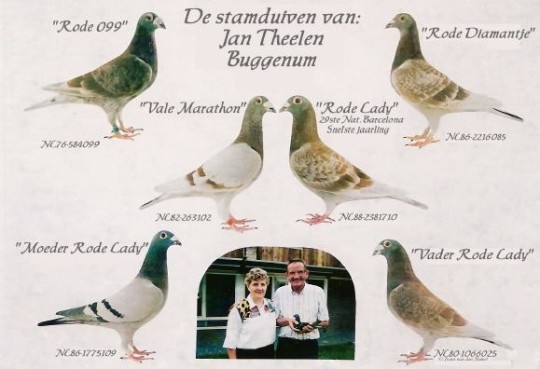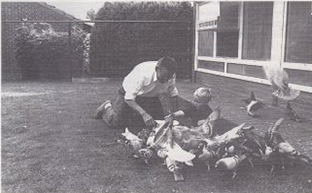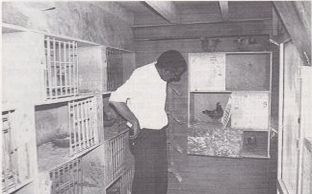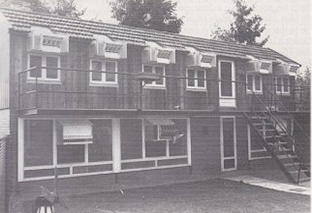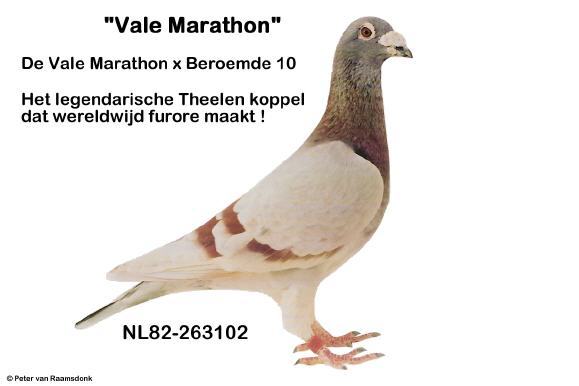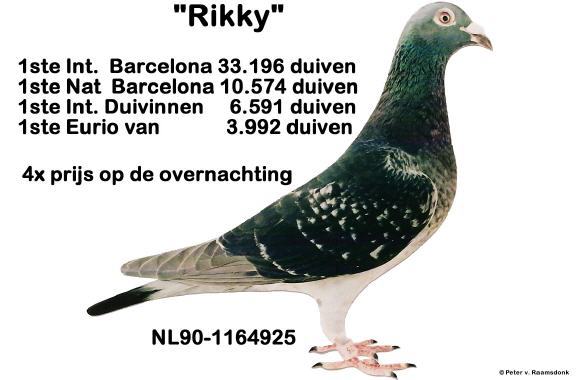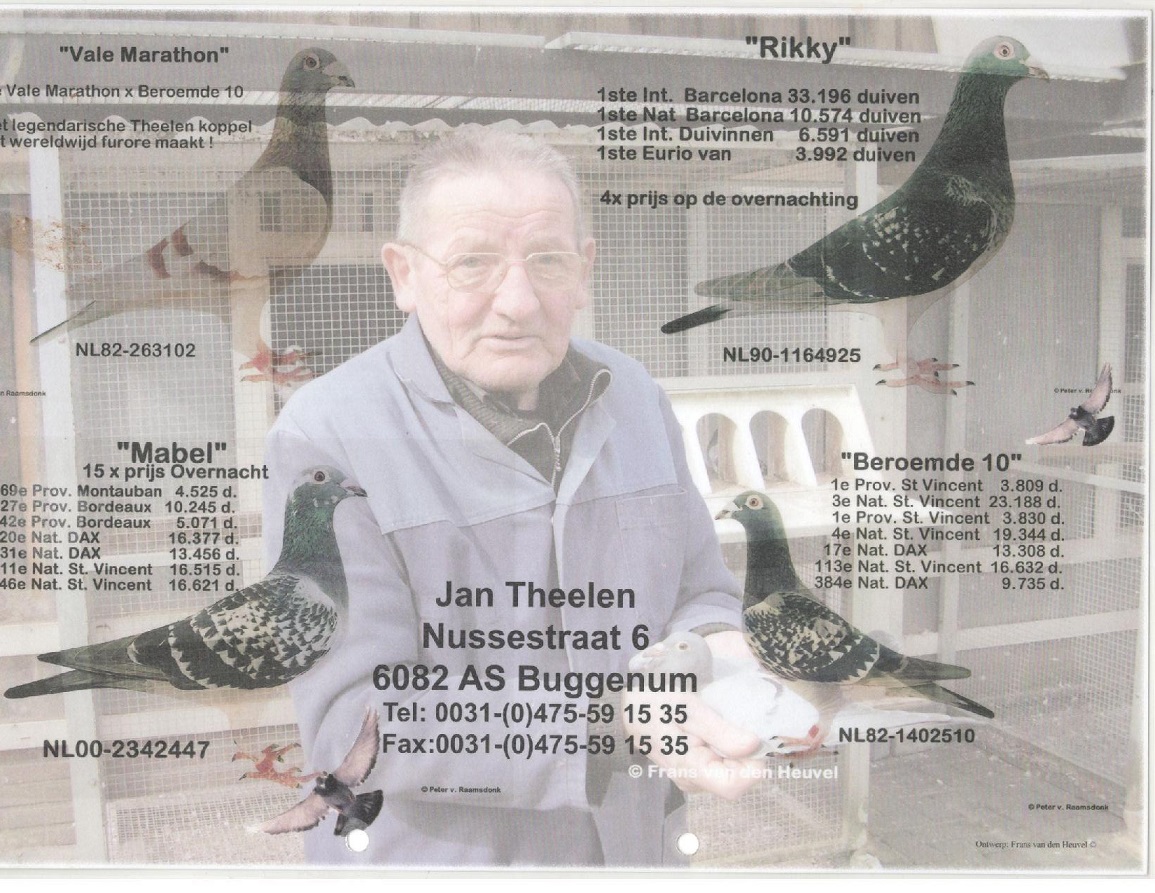Jan Theelen
Jan Theelen, Master Breeder, from Buggenum, Belgium.
- Steve O'Dea
- January 7, 2022
- 4:54 pm
Watch, Listen or Read about Jan Theelen below here....
Jan Theelen had it hard – he had to combine three things: a full-time job as a Craftsman, keep a Cafe & Banquet Hall open and run a pigeon colony! When he talks about the café and the hall, he usually talks about the “business”. Jan still pronounces it with some pride. As long as Jan still worked during the day in the weaving factory, Truus, his wife, had to keep the “business” open. The pigeons were cared for in the morning and in the evening. Although… in the morning… Jan was never an early bird since it often got late in the bar, there was not much time left before noon to take care of pigeons. Thus the pigeons had to adapt to a spartan regime in the Theelen household.
The career of Jan Theelen – say 50 years champion with pigeons – can be divided into three major periods, with the arrival of the Trutje in 1971, the total sale in 1990, and the 50 years of high-level pigeon sport interspersed with countless highlights – with one big constant: the breeding of absolute top pigeons. They are world famous: The Linkse, the 508, the Vale Marathon, the Red and Black Ladies, the Wonderful 10, the Liesbeth… Add to this the fact that Jan – like most true champions – has a nose for good pigeons and always managed to bring in the right pigeon at the right time without endangering his self-grown strain.
The Jan Jacobs Contribution
One of Jan Theelen’s first masterstrokes was the purchase in 1958 of the Lichtkras NL219004-54 from Jan Jacobs in Sevenum. This Lichtkras Jacobs was already 4 years old at the time, but Theelen had taken a good look: this and no other would become the only and real ancestor of the very old Theelen tribe.
Together with a Belgian hen, De Lichtkras immediately bred two champions for Jan: the Kleine Blauwe 449633-58 and his nest brother the Kleine Geschelpte 449634-58. This Kleine Geschelpte was coupled to a Witoog hen from Jan Poels from Halen and the Kleine Blauwe to the Donkere Witpen Witstaart from Wuts from Swalmen. Jan, who was not averse to a bit of inbreeding, coupled the children from this (nephew and niece) back to each other and his first breeding couple was born. It was the Geschelpte 283344-59 (out of the aforementioned Witoog x Kleine Geschelpte) and the Vuile Blauwe Witpen (out of the Kleine Blauwe with the Whitetail). They are the parents of the first famous pigeon that saw the light in Buggenum, the famous “Linkse” 1365903-63.
In order to broaden his base, Jan Theelen coupled the Lichtkras Jacobs to other hens that he liked. As late as 1958 he coupled the Lichtkras with a pure Hermans hen he had through a certain Ramakers from Heythuysen (Leudal). That was long before Theelen himself found his way to Jos Hermans. This successful pairing produced, among others, the Rode Witoger alias de Toegenaaide van 58. From this Toegenaaide, a top pigeon was born in 1959, namely the Rode Kampioen 46, in full 283346-59. In 1959 Jan Theelen paired the Lichtkras Jacobs to a hen from Kurstjens from Belfeld. It was another hit, because the Saint-Vincent hen rolls emanated out of this pairing. The latter, NL283242-59, won 68/2125 Saint-Vincent 1960 as a yearling and then became a noted breeder himself.
 “The career of Jan Theelen – say 50 years champion with pigeons – can be divided into three major periods, with the arrival of the Trutje in 1971, the total sale in 1990, and the 50 years of high-level pigeon sport interspersed with countless highlights – with one big constant: the breeding of absolute top pigeons.”
“The career of Jan Theelen – say 50 years champion with pigeons – can be divided into three major periods, with the arrival of the Trutje in 1971, the total sale in 1990, and the 50 years of high-level pigeon sport interspersed with countless highlights – with one big constant: the breeding of absolute top pigeons.”
The Linkse Line
The Linkse, BE 1365903-63 was inbred to the old Light Pencil Jacobs. As a yearling he won 1st Limoges and Jan Theelen – true to the motto “breed first, then play” – immediately stopped him for breeding. The bord was well noted, because the Linkse has become a top breeder. With a Schalie Witpen 373127-69, granddaughter of the Rode Kampioen 283346-59 (son of the aforementioned Toegenaaide), he produces the Son Linkse 1414293-71. This inbred lad also performed and wins 13th national Dax and 36, 80, 151 national Barcelona.
It is clear that Jan Theelen was on a gold vein in Buggenum, because all those descendants of the Jacobs cock bred so easily. Jan mated his Son of Linkse with a van Wanroy pigeon BE 1505232-71 from the line of the Sluitring via Breukers Sittard. This couple produces a new top pigeon; the famous 700, ring NL1734700-77. The 700 was a pigeon close to Jan Theelen’s heart as he could fly for two days. He proved that by winning 23rd and 377th national from Barcelona. He would also become a capital breeder as the sire of the Vale Marathon NL 263102-82 and the Zwarte Lady 1860811-79, among others.
Important for Jan Theelen as a master breeder was that he had a strong crossing line in addition to all the vigour of the now massively present Red Hermans pigeons.
When you think of Theelen pigeons, you inevitably think of Red and Mealy pigeons, even though Jan had many famous other coloured pigeons in his career. Almost everyone also knows that Jan Theelen mainly attained his Red pigeons from one Jos Hermans. Also, at Hermans, it was all Red and Mealy that proved to be superior performers. He mainly got his Red from Wegge and De Herdt and later from Dr. Bricoux, who also owned a predominantly Red colony of super pigeons… Theelen is in good company with his legion of Red pigeons.
Jos Hermans Junior inherited the colony of Jos Hermans Senior, and lived in Mariaburg. It was with Jos Hermans Junior that Jan Theelen got the core of his loft stock, including the Red & Mealy pigeons during the 60’s and 70’s.
What better way to illuminate the noble origins of the Theelen pigeons than by telling the story of the build-up of the pigeon stock of its most important suppliers: Jos and Jos Hermans. We can tell here the facts about the Hermans strain that have not been published due to a previously unpublished document by the late Herman Schuttelaar, a pigeon sport chronicler and family friend of Jos Hermans Jr. and – an important detail – of Jan Theelen.
The fanciers who succeeded with the Hermans pigeons and sometimes bred complete champion colonies from them cannot be counted. It is Herman Schuttelaar who shows him the way to the Herman Jnr. loft – the first time in 1963 and then again in 1971. Jan Theelen was in good company, because greats such as Stassart, Tournier sr, Fabry, Sion, Stok, the Oomens brothers, van Wanroy, Ko Nipius, Van Gulck, Pepermans, Docker, Tanghe and so many others had preceded him to bring the blood of those much sought-after Red Hermans pigeons into their home. They would also leave a lasting mark on the colony, and not only because of the Red colour.
Old Red Hermans
The first pigeon that Jan Theelen got from Jos Hermans was a Red one. How could it be different? It was a Cock, BE 6303906-63, “Oude Rode” which had the ZB44 (“Son Boot”) 4 times in his pedigree. He descended from the Binchou 6241816-47 on both his father’s and mother’s side. This Blue crack-pigeon was called “Binchou” because he was bought as a youngster in Binche. Binchou was also the nickname of Omer Taveirne, one of the better Belgian racers in the 1930’s. De Blauwe Binchou won for Jos Hermans, among other things, a 1st Angoulême with 35,000 birds in that race. We can safely say that the three main pigeons that Theelen attained in Mariaburg carried that Binchou blood to a large extent. Or is it from the Schulte who appears 3 times in the pedigree of the Oude Rode? This Schulte, a son of the ZB44, won the 1st national Bordeaux for Jos Hermans. It is important to note that the Oude Rode Hermans had all good bloodlines firmly “anchored” in the genes through inbreeding. The most important son that Jan Theelen bred from his Oude Rode Hermans was undoubtedly the champion pigeon “Goede Rode 834”, in full BE 851834-67.
 “Almost everyone also knows that Jan Theelen mainly attained his Red pigeons from one Jos Hermans. Also, at Hermans, it was all Red and Mealy that proved to be superior performers. He mainly got his Red from Wegge and De Herdt and later from Dr. Bricoux”
“Almost everyone also knows that Jan Theelen mainly attained his Red pigeons from one Jos Hermans. Also, at Hermans, it was all Red and Mealy that proved to be superior performers. He mainly got his Red from Wegge and De Herdt and later from Dr. Bricoux”
Old Dark Hermans
“The pigeon sales were going well at Jos Hermans” recalls Jan Theelen, “and you noticed that Jos Hermans was extremely friendly and helpful, but there was no question of choosing or anything. He decided what to take with you and there was no arguing about the price. I was quite impressed and at the same time happy that I could return home with a Red youngster and a couple of eggs.”
During his visit to Hermans, Jan Theelen also obtained a precious egg that was carefully presented and from which the Donkere Hermans was born, rung by Theelen with a Dutch ring NL63-1365990. Because everything at Jos Hermans was one big family, diligently inbred to a few top pigeons, the Oude Donkere was also quite closely related to the Oude Rode. They were both inbred to the ZB44, the Vos Wilde from ’52 and the inevitable Binchou. De Oude Donkere, however, had exchanged 25% foreign blood in his character through a pigeon with the Walloon champion Guillaume Peeters-Beaufort from Biomont.
Jan Theelen mated the Donkere to his own Lichte Saint-Vincent hen who had flown no less than 12 long distance prizes. From this master coupling came the “Goede 016”. De Goede 16 confirmed as an old pigeon and then became a more than important pawn in the breeding program. His most important son was the “Little Blue”. This “Klein Blauwe” with ring 1414298-71 won 11 prizes in the extreme long distance and in turn became a top breeder. He gave several champions who flew 8 to 10 prizes on the overnight. But we mainly remember him as grandfather of the world famous “Liesbeth”.
De Goede Rode (The Good Red)
De Goede Rode won 10 prizes in the extreme long distance and was co-winner of the first series 3 in the national Saint-Vincent 1974. With the results of this Goede Rode and of the above-mentioned Goede 16 it was more than clear that Jan Theelen with the contribution of the Hermans pigeons was now definitely on the overnight horse. Entering two Hermans pigeons and, coupled with his own species, proves a recipe for success. Numerous champions sprang from that line of the Goede Rode 834. For example, he became the father of the 20 breeding pigeon that we will encounter in the Kuijpers chapter. But also the 10, the Car winner, the Gouden Kweker and the Black Madonna of Lalieu-van Doorn, the Kuijpers 52 etc. carry his bloodline.
The Goede Kweker 348.
Jan in turn paired the Rode with the best from the old core, namely a daughter of the Rode Kampioen 46 with the Lichtkras Poels. This hen already contained some Hermans blood via Ramakers. This pairing produced a super pigeon: the Goede Rode 834, in full 851834-67. Jan Theelen did what he had to do: he brought his two Hermans lines back together. He mated the Goede Rode to a daughter of the Goede 16 (then coupled to the 1105591-68 an HVR via Dr Linsen) and with that he made the move of his life, because this resulted in an absolute top breeder: the Goede Kweker 348.
 “The pigeon sales were going well at Jos Hermans” recalls Jan Theelen, “and you noticed that Jos Hermans was extremely friendly and helpful, but there was no question of choosing or anything. He decided what to take with you and there was no arguing about the price”
“The pigeon sales were going well at Jos Hermans” recalls Jan Theelen, “and you noticed that Jos Hermans was extremely friendly and helpful, but there was no question of choosing or anything. He decided what to take with you and there was no arguing about the price”
The Famous 08
The very first youngster from Trutje x Goede Kweker 348 was the “Fameeuze 08” with the ring BE 580508-72. The 08 was born a “Super”. He immediately understood what was expected of him and had already won 11 prizes as a yearling, including 1st Orléans. In 1974 he started again with 6 top prizes, but then came home injured. A miracle that he still came home, because otherwise the pigeon history would have looked completely different… Jan did not hesitate and put him straight in the breeding loft. “The very best I ever had,” muses Jan Theelen, “if I ever wanted to have one pigeon back, it would be him.”
It’s not only Jan Theelen who would succeed with the descendants of the 08: the Car winner at van de Eijnde-Bernhards, the Rode 50 Vertelman, the Gouden Kweker Brinkman, the Ancestor Wiel Cramers, the Vale Marathon, etc. are all descendants and all carry his genes.
The Fameeuze 08 was coupled to various hens, such as: the Vuile hen 1414252-71 from the Broer van De Linkse; the Van den Bosch duivin, a direct from Berlaar with ring B6433755-68 (mother of the 1st provincial Dax); a direct Matterne from the line of his national and international winners; the 373253-69 and finally the so-called van der Ween duivin.
The best of these partners was undoubtedly the latter: van der Weenduivin, NL877244-78, a van der Wegen x Wiel Joosten via Strijbosch from Venray. With this the 08 gave the famous Marathon hen – the “60”. She would win the National Marathon in 1984 with her son Vale Marathon.
Another “08”, namely the 708 or 1860708-79, was a direct son of the Famous 08 and also flew like a champion. He won thirteen prizes in 1981 with 1, 2, 3, 3, 9 and did this again in ’82: 10 prizes to Bergerac with 1, 2, 7, …
Three other sons of the 08, better known as the three musketeers 1472143-75; 9345585-78 and 235047-81 each win a series of prizes, each with a 1st place on the overnight in the Samenspel.
And that is of course only a small selection of the prizes of the direct descendants of the 08. At least 20 top pigeons also came from the 08. In the wake of the 08 we meet world class champions such as the El Torro of Kaelen-Broers, the Rode 50 Vertelman, the Vale Bordeaux of Piet de Vogel, the 2 national Bergerac from the Kuijpers brothers, the 1st national Bergerac van Bennie Homma, the 1 national Lourdes by Jo Funcken, 10 national Barcelona from Cees van de Poel, and even Sumari and Sumara from the Brügemann brothers (10th and 18th national Barcelona).
Roger Van Gulck
Roger Van Gulck hailed from Kallo. He also had a colony of Herman pigeons which he was noted for as one of the principal long distance flyers in the province of Antwerp. Jan Theelen knew about these Hermans pigeons through Schuttelaar and visited Kallo in 1964 to get even more Hermans blood in to his lofts. The most important acquisition here was the “Guarantee hen” because Van Gulck sold the pigeon with a guarantee: not a good one? – then a full refund ! That’s how sure you could be of the breeding of those Hermans pigeons. Furthermore, Jan Theelen obtained from all good lines: Vuile Blauwe, Manke Rode, Coppi, etc. in short, from all the pigeons with which Van Gulck dominated in the long distance racing in the province of Antwerp.
 “The most important acquisition here was the “Guarantee hen” because Van Gulck sold the pigeon with a guarantee: not a good one? – then a full refund !”
“The most important acquisition here was the “Guarantee hen” because Van Gulck sold the pigeon with a guarantee: not a good one? – then a full refund !”
“Trutje”
Jan Theelen refers to the entire dynasty of “The Trutje”, who he revered as the best breeding hen that ever lived in Buggenum, directly from Jos Hermans. Strengthened by the undeniable success of the Hermans contribution, Jan Theelen returned to Mariaburg-Kapellen in 1971. He attained six youngsters, of which one Red hen in particular was a bull’s eye: the unparalleled Trutje, ring B6770696-71. With the breeding talent of his own, Jan Theelen couples this Trutje with the best he already had from Jos Hermans: the aforementioned “Goede Kweker 348”. It is clear that Jan deliberately uses careful inbreeding, because Trutje came from a half-brother of his Oude Rode Hermans, grandfather of the Goede Kweker 348.
Nothing but champions came out of this couple. “At least 20,” says Jan Theelen, with a firmness that leaves no room for doubt. At least 15 to 20 children from this super couple were able to prove themselves in Buggenum, either in breeding or in the heavy work.
The Red 99
A brother of the 08 and thus, another famous son of the royal couple 348 x Trutje, was the Rode 099, ring NL 584099-76. In ’78 he bred the “Goede Kweekduivin”, NL934639-78, from Lalieu-van Doorn, and insiders know what that put into the world. For example, she is grandmother of the “Sonja” from the Hagens Bros., 1st International Perpignan in 1996. She is also the mother of the phenomena of Lalieu-van Doorn such as the Zwarte Madonna 267624-81 and the Dolle Greet 1082936-80, in turn mother of the 1st Provincial Bourges at the Theelen loft itself. De Goede Kweekduivin is also great-grand dam of Early Bird, 1st national Saint Vincent at Ravelli-Ramakers.
At 14 years old, the Rode 099 was still one of the eye-catchers at the total auction in 1990 and went to the breeding plant of Jaap van der Heiden together with his famous stable mates. One of those stable mates was also a daughter of the Rode, namely the promising breeding hen “Vetblauw Mooioog”.
The Sticky Hen
The Plakduivin, a granddaughter of Dikke Rode 2, was also included in the lot of young Hermans pigeons of 1971. The Plakduivin was slightly less dominant in the stock formation of Theelen, but she was the paternal grandmother of the Famous 10.
 “Nothing but champions came out of this couple. “At least 20,” says Jan Theelen, with a firmness that leaves no room for doubt.”
“Nothing but champions came out of this couple. “At least 20,” says Jan Theelen, with a firmness that leaves no room for doubt.”
The Zwarte Lady
With the Zwarte Lady, 1860811-79, we are the sixth generation of champion pigeons from the Lichtkras Jacobs line. As mentioned, the Zwarte Lady was a daughter of the 700. In barely 6 weeks the Zwarte Lady flew:
6/18532 national Saint Vincent 1983
64/8243 national Dax 1983
18/13302 Bergerac 1983
This made her the best long distance pigeon in the Netherlands in the WHZB classification of the NPO. In the same effort she became Ace Pigeon 1983 of the Phoenix, but also of the Limburg Long Distance Club.
Red Lady
After a Black Lady, Jan Theelen bred a Red Lady in 1988, and then a Red Lady Barcelona, ring NL2381710-88. After all, she achieved 29th national as a yearling, winning from Barcelona against 6,443 pigeons. A glorious achievement and unique in the sense that she was the very first yearling in the national and international results.
The sire of the Red Lady was once again a brother of the Famous 08, the Red NL1066025-80. Considering the age of the parents (both the 348 and the Trutje were from 1971) this beauty was immediately placed in the breeding loft.
The dam of the Rode Lady was a pigeon, NL1775109-86, which Jan was allowed to select from the widow of Joep Rumkes from Schinveld. Jan loved this hen that came from a direct Kuijpers, a son of the 20-Kweekduif with a daughter of the Barcelona II. Her mother was a kind of Aarden via Ligtenberg and Brocatus. To be sure, Jan also took her sister with him.
This female powerhouse proved, among other things, that Theelen took a good look at it with her winning the top prize from Barcelona as a yearling. As a 2-year-old she flew again per ten from Barcelona to move to Jaap van der Heiden that same year via the total auction.
In that period Theelen was blessed with some strong Barcelona racers. The Red Barcelona NL1943954-85 was also a phenomenon, winning 86th National in 1988 and 44 national in 1989 – both results from Barcelona. He came from a son of the Famous 08 with a Kuijpers Brothers hen.
National Marathon Champion
With his Red legion, Jan Theelen was hard to beat in the eighties and therefore also a formidable contender in the National Marathon Competition. He wins, among other things:
in 1983 5th national Marathon, 2nd in the provincial Limburg Marathon (after Lalieu-van Doorn with pigeons from Theelen!)
in 1984 1st national Marathon: Marathon champion Netherlands 1984 with the Vale Marathon and his mother the 60 hen
in 1985 8th national Marathon
and in 1986 4th national marathon.
The big winners in 1984 are mother and son! Mother is the aforementioned Rode 60 hen, 1066060-80, daughter of the Fameeuze 08. She is Jan’s first clocked pigeon from Dax and Bergerac. She wins 3 x 1st in the Samenspel. In total she won 10 prizes in the extreme long distance and finally lost in the field of honour from Bergerac.
Her son is the now world-famous Vale Marathon, NL 263102-82. This “102” as Jan still calls it, peaks with 77 national Barcelona.
But as mentioned, he earned his name by winning the National Marathon in ’84 with his mother. Another highlight in Theelen’s career.
In time, Vale Marathon goes on to become a professional breeder. He is, for example, father of the Blauwe Pau, 7 national Pau 1990. Together with the 10 he will give birth to a pleiade of champions, led by a jewel of a pigeon: the Red Diamond and all her entourage. An illustrious brother was in particular the already famous Vale Nero van Fons van Ophuizen.
Het Rode Diamantje, ring 2216085-86, is, among other things, the grandmother of the Primus Inter Pares of Pros Roosen from Kermt, Belgium.
Another son of the 60 hen was the 704; this one was not wrong either with 11, 53 and 65 provincial Dax and 76 provincial Saint Vincent.
The titles follow for Jan Theelen in quick succession.
1980 1st General Champion Phoenix
1981 1st General Champion Phoenix
1982 1st General Champion and Emperor of the Phoenix
In 1982 General Champion Fondclub Limburg
In 1984 Jan wins a super series from Saint-VincentIn short, things are going great in Buggenum. Jan Theelen continuously breeds pigeons that are practically indispensable in the extreme long distance. It is almost impossible to count the number of series he has won with this and rightly gives him the international reputation of a strong series winner.
 “He wins, among other things: in 1983 5th national Marathon, 2nd in the provincial Limburg Marathon (after Lalieu-van Doorn with pigeons from Theelen!) in 1984 1st national Marathon: Marathon champion Netherlands 1984 with the Vale Marathon and his mother the 60 hen in 1985 8th national Marathon and in 1986 4th national marathon.”
“He wins, among other things: in 1983 5th national Marathon, 2nd in the provincial Limburg Marathon (after Lalieu-van Doorn with pigeons from Theelen!) in 1984 1st national Marathon: Marathon champion Netherlands 1984 with the Vale Marathon and his mother the 60 hen in 1985 8th national Marathon and in 1986 4th national marathon.”
The phenomenal 10
In 1982 the umpteenth crack pigeon is born in Buggenum, namely the wonderful “10”. The 10, in full NL 1402510-82, won the provincial Saint-Vincent two years in a row against the top of Limburg – each time against almost 4,000 pigeons. Nationally that is good for:
– 1985 4th national of 19,344 pigeons
– 1986 in very heavy weather, 3rd national against now 23,188 pigeons
In 1984 she also won 75th provincial Dax and 113th out of 16,632 national Saint Vincent (11th provincial)
In 1985, in addition to her provincial victory, she also won 17th out of 13,308 national Dax (6th provincial)
In 1987 the 10 returned from Saint Vincent injured and was then wisely kept at home for breeding. Finally, she was sold for a capital sum to Japan via Jan Hermans.
The Kuijpers input
It is a well-known fact that Jan Theelen is good friends with his fellow countrymen the brothers Piet and André Kuijpers from Neer. It is equally well known that the Kuijpers brothers really beat Barcelona in the years 1975-1980 (with 1, 2, 3, 3, 7, 13, 21 national Barcelona) and this with brothers and sisters from their unparalleled royal couple “Son Spin x Zuster Pau”. This, of course, did not escape family friend Jan Theelen, who often exchanged pigeons with the brothers. The Kuijpers brothers actually already owned a super hen from Jan, namely the NL812520-70, better known as the “20-Kweekduif”, a daughter of the Goede Rode 834.
This 20-Kweekduif became the mother of their 99-Kweker. An incredible sire who is also grandfather of at least 4 real phenomena:
- the Super breeder 2122446-83 from Jo van Haaren
- de Emerald I, 1200025-82 1st international Barcelona female. In 1984 and 2nd international Barcelona female. 1985 for Wim van Leeuwen
- the Emerald II, 1st international Barcelona 1988 Wim van Leeuwen
- the Sherpa, 865526-83 or the 1st national Barcelona 87 by Laban van Noordenne from Hardinxveld
Kuijpers 52
Jan Theelen obtained the NL578152-76, known throughout the pigeon world as the “Kuijpers 52”. De Kuijpers 52 came from Neer from the nest brother of the Barcelona I, 1st and 3rd national Barcelona, against a daughter of the aforementioned 20 breeding pigeon. He would become a superior breeder in Buggenum, including father of the Liesbeth. The Kuipers 52 was actually also a 25% Theelen.
Golden Kuijperke 494
Another top pigeon from Kuijpers was the Gouden Kuijperke, NL1063494-83. The nickname actually says it all: a gold nugget. Other famous grandsons of the Gouden Kuijperke were the Dax and the Blauwe Pau. The Dax won 2nd against 926 pigeons from Dax ZLU; 3rd against 1,204 euregion, 11th against 9,202 birds international while the Pau was good for 7th national Pau and 83rd national Bordeaux.
She was also an excellent breeder and produced birds which were proven by Eijerkamp: the Blauwe Musketier, again a grandson of the Gouden Kuijperke, twice won the 1st prize prov. From Barcelona.
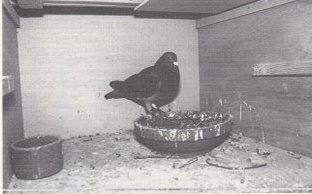
Lisbeth
However, the most famous Kuijperstelg in Buggenum was the Liesbeth, NL934525-78. Liesbeth became immortal by winning the 1st prize provincial from Saint-Vincent in 1981 against about 9,000 pigeons. Her performance was further enhanced by the 1-hour lead over the nearest competition, in inhumane weather conditions. Liesbeth was a daughter of the Kuijpers 52. In 1982 the Liesbeth, named after the daughter of Theelen, won 61st against 16,935 birds national Saint Vincent. In 1983 she regained Jan Theelen’s confidence, but it was one flight too many: unfortunately, she was lost from Dax. She managed to produce a series of very solid, long-distance birds including
– 159499-84 with 9 prizes including 19th national Dax, 194th national Dax and 231st national Saint-Vincent
– 1063450-83 with 10 prizes with 25th national Saint Vincent, 77th national Dax and 125th national Bergerac.
In the last ten years before his sale in 1990, Theelen won 48% prizes in the extreme long distance. Just say 1 in 2. On paper it all seems very feasible, but if you participate in all flights like Jan and each time with a not small number of pigeons, it is nevertheless a world achievement and proof that you almost continuously have a core of pigeons that not to be missed and on which you can build a cathedral.
Jan sold everything in 1990. But the urge for pigeons and pigeon racing was much stronger than he ever suspected. Before he knew it he was back with pigeons and just as quickly he was back with the champions.

